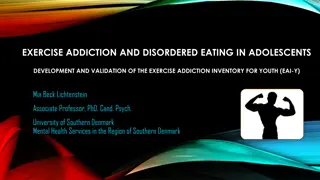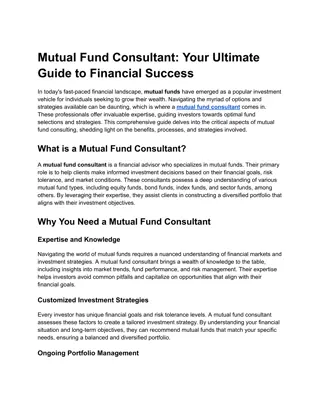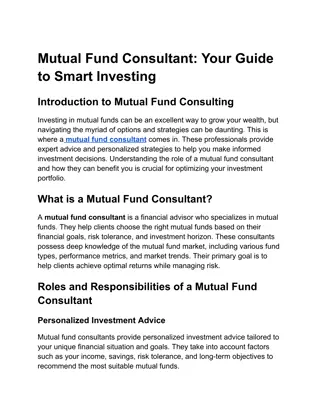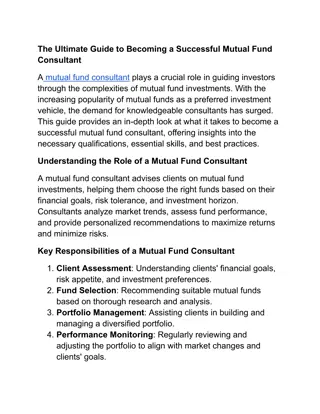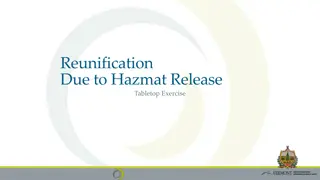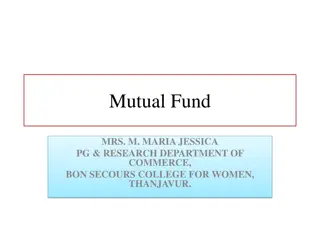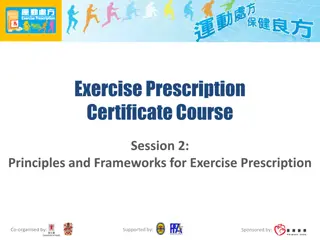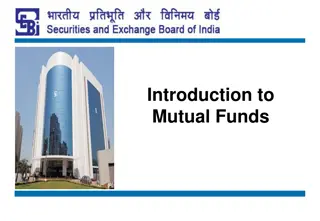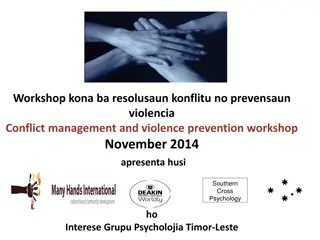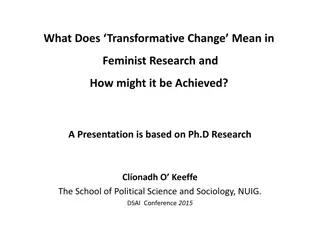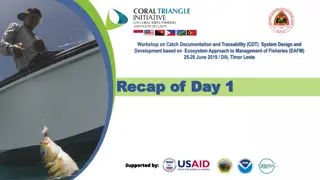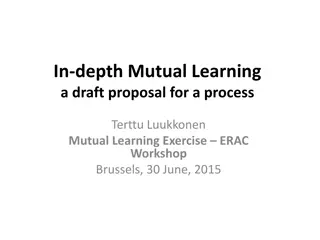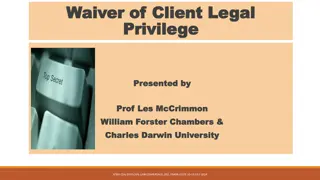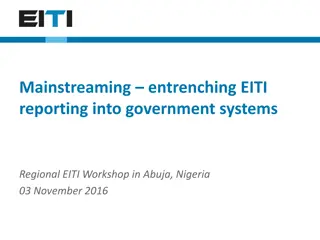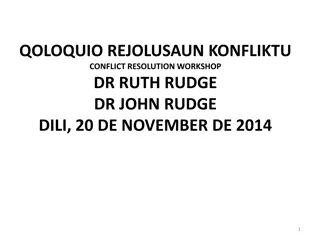Mutual Learning Exercise on R&I Strategies and Policies in Timor-Leste
To provide context and an overview of the R&I Ecosystem in Timor-Leste, this exchange discusses key background factors, including the absence of a formal STI policy. Despite progress in STI policy development, challenges remain in securing adequate budgeting for STI initiatives. Various stakeholders, such as government bodies, research hubs, and private companies, play key roles in supporting the implementation of STI policies in the country.
Download Presentation

Please find below an Image/Link to download the presentation.
The content on the website is provided AS IS for your information and personal use only. It may not be sold, licensed, or shared on other websites without obtaining consent from the author.If you encounter any issues during the download, it is possible that the publisher has removed the file from their server.
You are allowed to download the files provided on this website for personal or commercial use, subject to the condition that they are used lawfully. All files are the property of their respective owners.
The content on the website is provided AS IS for your information and personal use only. It may not be sold, licensed, or shared on other websites without obtaining consent from the author.
E N D
Presentation Transcript
MUTUAL LEARNING EXERCISE ON R&I STRATEGIES AND POLICIES Jos Corn lio Guterres Instituto Nacional de Ci ncia eTecnologia Timor-Leste Addis Ababa, Ethiopia 14-17 February 2023
1: Background and country context To provide context and an overview of the R&I Ecosystem What are the key R&I and/or STI background and contextual factors that are relevant to this MLE? Timor-Leste has no policy for science, technology and innovation. But the Government Resolution No. 1 /2022 of 26 January, on the National Policy of Higher Education also absorbed STI policy. The creation of INCT really give hope to create STI policy of Timor-Leste. What is the status of my R&I and/or STI policy? In cooperation with the PSF-OACPS, STI policy has been in place. It was accomplished and launched in June 2022. The existence of 19 HEIs, research hubs, private companies, they show their full support the the implementation of STI policy in the country. Though, the government is still reluctant to allocate more budget in the STI development.
2: Understanding the R&I (and STI) Ecosystem I The main R&I ecosystem actors and stakeholders in Timor-Leste Government: Government ; The Research Unit of the Ministry of Education, Science and Culture, Cultura (MESCC), the Parliamentary Research Centre, the Research Departments of the Ministry of Trade, Commerce and Industries, the Ministry of Agriculture, Forest and Fisheries, the Ministry of Tourism, the Ministry of Finance, the Ministry of Public Health, the Ministry of Public Administration, the Ministry of Social Solidarity, the Ministry of Planning and Territories, the Ministry of Public Work, the Ministry of Transport and Telecommunication, the Ministry of Petroleum and Minerals, and the Telecommunication Information Communication (TIC) Timor-Leste; Research Hubs: The 19 universities across Timor-Leste; and several research centres including the Digital Library and the National Centre for Scientific Investigation (CNIC) of Universidade Nacional Timor-Lorosa e (UNTL), the Centro Estrategico da Paz (CePAZ) of Universidade da Paz (UNPAZ), the Asosiasaun Peskizadores Timor-Anan (the Timorese Research Association), the Centre of Studies For Peace and Development (CEPAD Timor-Leste), thenon-governmental organisation (NGO) Lao Hamutuk, the TID Research Centreand the Institute of Petroleum and Geology, Timor-Leste.
3: Understanding the R&I (and STI) Ecosystem II The main R&I ecosystem actors and stakeholders in Timor-leste Industry: the Oil, and natural gas generators, furniture, machines, equipment, supplies, home essentials, food and beverages, primary industry (including agriculture and fisheries), transportation, logistics and courier services; industries, construction and renovation, heavy equipment/machinery, IT Agencies; From the private sector and the IT Agencies including Telcomsel (an Indonesian owned company), Timor Telecom, Gardamor (Timor-Leste privately-owned companies), and Telemor (a Vietnamese owned company). Private Business Sector; Equipment companies, media and communication training, consulting and scientific services, financial and legal services, restaurants and catering, health and medicine, security services and equipment, handicrafts and artisans, printing and copying, entertainment and leisure, goods and services, laundry, cleaning services and waste collection companies, associations, unions, cooperatives and NGOs.
4: R&I Ecosystem Analysis - I Strengths, opportunities, weaknesses and threats in Timor Leste R&I / STI ecosystem SWOT ANALYSIS STRENGTHS WEAKNESSES Limited human capabilities to launch STI agenda and foster thriving STI communities; Political will of the governement to creat the National Institute of Science and Technology to initiate the creation and implementing the STI policy agenda. Indigenous, rural populations and women have limited Access to STI and are not actively engaged; Technological partners (telecom companies) are interested to support an open science approach, in particular the NDR; Lack of physical and (e-)infrastructure facilities to support STI activities at local, national and international levels; 19 HEIs manifest their full support the development of STI policy implementation. Lack of engagement with international research and innovation networks; The existence of Journal of Business and Management, which is an international, online, open access and peer-reviewed journal; Lack of a legal deposit where works can be deposited the scientific materials. Close collaboration with UNESCO, European Union, Association of Southeast Asian Nations, Southeast Asian Ministers of Education Organisation (SEAMEO)/ Regional Institute for Higher Education (RIHED). Very few open access journals launched in Timor-Leste Only 2 % of the lecturers have a doctorate (PhD) Still Low levels of business R&D and innovation Development (SEAMEO/RIHED), (CPLP), (AULP), F rum de Gest o de Ensino Superior (FORGES); Low private-public partnerships Geographical Indon sia, Singapore Thailand etc. closeness to neigboring Countries : Australia, High price of data/connectivity.
5: R&I Ecosystem Analysis - II Strengths, opportunities, weaknesses and threats in Timor Leste R&I / STI ecosystem SWOT ANALYSIS OPPORTUNITIES THREATS Submarine cable to connect Timor-Leste to Australia. Percentage of Petroleum Fund being redirected to support STI. Telecom companies willingness to offer zero rating (as long as they all have the same access). Become a reference for STI and in particular open STI policies in small island developing states. Engagement by different key stakeholders. Human resources potential with young workforce COVID-19 has posed more limitations to Timor-Leste by further reinforcing the triple isolation: island state, poor land and maritime connections (for instance, very few and scattered flights without clear timetables), poor and costly telecommunications connectivity. Climate change brings altered conditions and a rise in temperature (World Bank29). Rising costs of goods and services due to current crisis, which fuelled the prices of petroleum and gas. Human resources with low STI capabilities
6: R&I Ecosystem Analysis - III To help identify and assess framework conditions that may foster or hinder transformative change through R&I policy PESTEL Political Economical Social Technological Environmental Legal Dedicated infrastructure for research must be part of the national budget; Research communities to allow the knowledge to be retained (group of young people); Infrastructure required to retain knowledge; SDG linked to environmental goals; Laws to Support the STI policy are missing; The Constitution of Timor-leste not state clearly about STI policy. Poor internet connectivity and fibre optic cables; High risk of climate- related; Property rights law being drafted; Government change in every five years also may lead to the change of policies; Financial resources are limited, reliant on Petroleum Fund; System of recognition and rewards at university and research level needed; Zero patentes have been filed (World Intellectual Property Organisation); Lack of open access journals, with International standards; Focus on STI policy as a priority to drive growth, supporting the Petroleum Fund, facilitating agriculture, tourism and other emergente sectors; Digital natives not being Engaged; Trademark registrations hit a peak in 2015, with 111 trademarks registrations, and declined substantially since then, with 5 trademarks being Registered in 2019 and 1 in 2020. National Strategy of did not envisage STI Evidence-based policy missing; Low STI skill sets with lack of programmers, inventors, thinkers; Community and civil society, NGOs, national, international, and also private sector not active in STI; Research results are not always used by the decision makers.
7: Transformation and Development Impacts Establish links to the broader/global context of the SDGs It is intended that a science, technology and innovation policy be developed in the country that promotes and stimulates scientific research in the country and publication on; SDG 2: Eradicate Hunger SDG 3 Health SDG 4 and 5: Education and Gender Equality SDG 6: Drinking Water and Sanitation SDG 7: Renewable and Accessible Energy SDG 8: Decent Work and Economic Growth SDG 9: Industry, Innovation and Infrastructure SDG 13: Climate Action SDG 14: Protecting Maritime Life SDG 15: Protect Life on Land
8: Conclusion insights for MLE Three (3) main recommendations/lessons on R&I policy from my country that can inform mutual / policy learning 1. It is required to develop four pillars for Timorese STI policy based on the quadruple helix of innovation : STI programme formulation; National Digital Repository; Open science cloud (e- Colaboratorio Nacional) and Physical infrastructure. 2. Start establishing international partnerships and Collaboration with national and international stakeholders is also a key element. 3. The Government of Timor-Leste should allocate funding for STI implementation starts 0.25% of GDP be set for research, rising to 1% after 5 years.
9: References RESOLU O DO GOVERNO N 1/2022 (2022). Pol tica Nacional de Ensino Superior. Jornal da Rep blica I S rie. N 3 (2022-01-26), 146-179. Available in: https://www.mj.gov.tl/jornal/public/docs/2022/serie_1/SERIE_I_NO_5.pdf. OACPS SECRETARIAT (2022). PSF Policy Recommendation Report Timor-Leste. OACPS R&I Programme Policy Support Facility. PSF: Brussels. Available in: https://inct.gov.tl/relatorio-de- recomendacao-politica-timor-leste/. NATIONAL INSTITUTE OF SCIENCE AND TECHNOLOGY OF TIMOR LESTE (2022). INCT'S STRATEGIC PLAN. INCT:Dili. Available in: https://inct.gov.tl/plano-estrategico-inct-2022-2030/.


